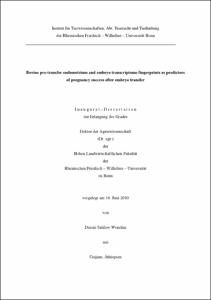Salilew Wondim, Dessie: Bovine pre-transfer endometrium and embryo transcriptome fingerprints as predictors of pregnancy success after embryo transfer. - Bonn, 2010. - Dissertation, Rheinische Friedrich-Wilhelms-Universität Bonn.
Online-Ausgabe in bonndoc: https://nbn-resolving.org/urn:nbn:de:hbz:5N-22956
Online-Ausgabe in bonndoc: https://nbn-resolving.org/urn:nbn:de:hbz:5N-22956
@phdthesis{handle:20.500.11811/4225,
urn: https://nbn-resolving.org/urn:nbn:de:hbz:5N-22956,
author = {{Dessie Salilew Wondim}},
title = {Bovine pre-transfer endometrium and embryo transcriptome fingerprints as predictors of pregnancy success after embryo transfer},
school = {Rheinische Friedrich-Wilhelms-Universität Bonn},
year = 2010,
month = oct,
volume = 148,
note = {Aberrant endometrial and embryonic gene expression is one of the causes of pregnancy failure in cattle. However, selecting cows with adequate endometrial receptivity and embryos of higher developmental competence based on the gene expression pattern has been a greater challenge. To investigate whether the pre-transfer endometrial and embryonic gene expression pattern has a direct relation with upcoming pregnancy success, a global endometrial and embryonic transcriptome analysis was carried out in endometrial and embryo biopsy samples using GeneChip® Bovine Genome Array and preimplantation specific cDNA array, respectively. For this, endometrium biopsies were taken at days 7 and 14 of the estrous cycle in Simmental heifers during the pre-transfer period. In the next cycle, in vivo produced day 7 blastocysts were transferred to the recipients at day 7 of the estrous cycle after taking 30-40% parts of the blastocyst as a biopsy for transcriptome analysis. After pregnancy diagnosis, the heifers were classified as calf delivery (receptive endometrium) and no pregnancy (non-receptive endometrium) groups. Subsequently, the endometrial biopsies (taken at days 7 and 14 of the estrous cycle) and the embryo biopsies were categorized as calf delivery or no pregnancy groups. The results revealed 1126 genes were differentially expressed between receptive and non-receptive endometrium at day 7 of the estrous cycle. These differences were accompanied by qualitative and quantitative alteration of major biological process and molecular pathways including cellular localization, post-transcriptional modification, signal transduction, apoptosis, cell cycle and immune response. However, only 14 genes were differentially expressed between receptive and non-receptive endometrium at day 14 of the estrous cycle. Furthermore, the transcriptome dynamics of receptive and non-receptive endometrium between day 7 and 14 of the estrous cycle revealed 1867 and 254 differentially expressed genes, respectively. The higher number of differentially expressed genes and functional categories between day 7 and 14 of the estrous cycle in receptive compared to non-receptive endometrium revealed the transcriptome plasticity of receptive endometrium. In addition, the gene expression profile in embryos biopsies resulted in calf delivery and those resulted in no pregnancy revealed 70 genes to be differentially expressed between the two embryo groups. Among those, 32 genes including SPAG17, PF6, UBE2D3P, DFNB31, AMD1, DTNBP1 and ARL8B were elevated in calf delivery groups and 38 genes including SGK1, GBF1, KRT8, DTX2, RNF34, ARL8B, RYBP and EEF1 were elevated in no pregnancy embryo groups. Therefore, the present study highlights the potential of pre-transfer endometrial and embryonic gene expression patterns as predictors of pregnancy success in cattle.},
url = {https://hdl.handle.net/20.500.11811/4225}
}
urn: https://nbn-resolving.org/urn:nbn:de:hbz:5N-22956,
author = {{Dessie Salilew Wondim}},
title = {Bovine pre-transfer endometrium and embryo transcriptome fingerprints as predictors of pregnancy success after embryo transfer},
school = {Rheinische Friedrich-Wilhelms-Universität Bonn},
year = 2010,
month = oct,
volume = 148,
note = {Aberrant endometrial and embryonic gene expression is one of the causes of pregnancy failure in cattle. However, selecting cows with adequate endometrial receptivity and embryos of higher developmental competence based on the gene expression pattern has been a greater challenge. To investigate whether the pre-transfer endometrial and embryonic gene expression pattern has a direct relation with upcoming pregnancy success, a global endometrial and embryonic transcriptome analysis was carried out in endometrial and embryo biopsy samples using GeneChip® Bovine Genome Array and preimplantation specific cDNA array, respectively. For this, endometrium biopsies were taken at days 7 and 14 of the estrous cycle in Simmental heifers during the pre-transfer period. In the next cycle, in vivo produced day 7 blastocysts were transferred to the recipients at day 7 of the estrous cycle after taking 30-40% parts of the blastocyst as a biopsy for transcriptome analysis. After pregnancy diagnosis, the heifers were classified as calf delivery (receptive endometrium) and no pregnancy (non-receptive endometrium) groups. Subsequently, the endometrial biopsies (taken at days 7 and 14 of the estrous cycle) and the embryo biopsies were categorized as calf delivery or no pregnancy groups. The results revealed 1126 genes were differentially expressed between receptive and non-receptive endometrium at day 7 of the estrous cycle. These differences were accompanied by qualitative and quantitative alteration of major biological process and molecular pathways including cellular localization, post-transcriptional modification, signal transduction, apoptosis, cell cycle and immune response. However, only 14 genes were differentially expressed between receptive and non-receptive endometrium at day 14 of the estrous cycle. Furthermore, the transcriptome dynamics of receptive and non-receptive endometrium between day 7 and 14 of the estrous cycle revealed 1867 and 254 differentially expressed genes, respectively. The higher number of differentially expressed genes and functional categories between day 7 and 14 of the estrous cycle in receptive compared to non-receptive endometrium revealed the transcriptome plasticity of receptive endometrium. In addition, the gene expression profile in embryos biopsies resulted in calf delivery and those resulted in no pregnancy revealed 70 genes to be differentially expressed between the two embryo groups. Among those, 32 genes including SPAG17, PF6, UBE2D3P, DFNB31, AMD1, DTNBP1 and ARL8B were elevated in calf delivery groups and 38 genes including SGK1, GBF1, KRT8, DTX2, RNF34, ARL8B, RYBP and EEF1 were elevated in no pregnancy embryo groups. Therefore, the present study highlights the potential of pre-transfer endometrial and embryonic gene expression patterns as predictors of pregnancy success in cattle.},
url = {https://hdl.handle.net/20.500.11811/4225}
}






